This is Via della Conciliazione, the boulevard that leads from St. Peter's Basilica to the Tiber river. I like this picture a lot for its 1930s vibe—which is appropriate since that's when Mussolini built this road.

Cats, charts, and politics

This is Via della Conciliazione, the boulevard that leads from St. Peter's Basilica to the Tiber river. I like this picture a lot for its 1930s vibe—which is appropriate since that's when Mussolini built this road.

The US death rate from COVID-19 is no longer skyrocketing, but it's still going up. Our mortality rate is 150% above Britain and more than 1000% higher than Germany.
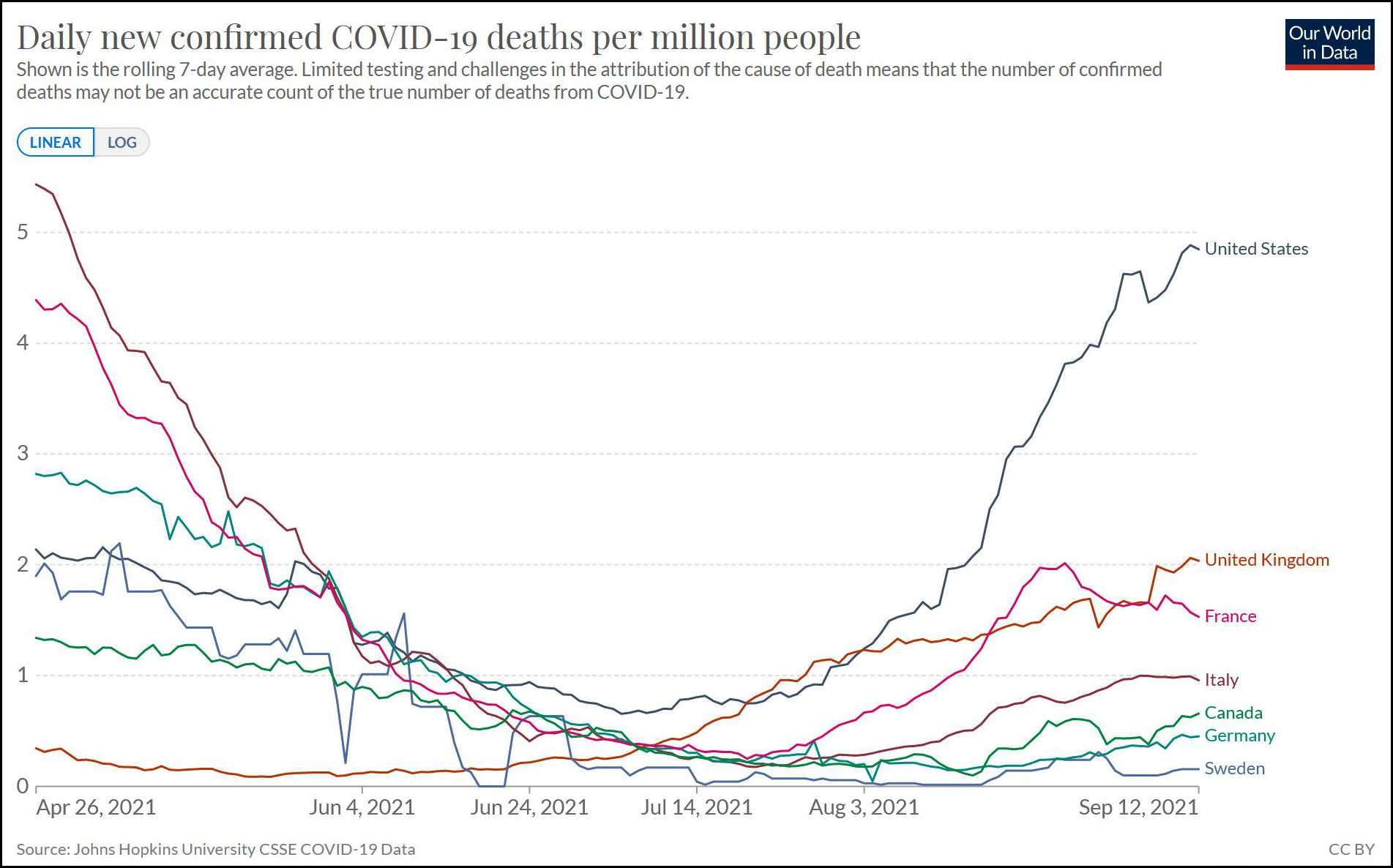
The LA Times reports on the latest outbreak of COVID-19 in California:
The Delta variant surge reached critical levels in parts of the Central Valley this week, with some hospitals overwhelmed by a crush of COVID-19 patients and Fresno County officials warning they might take drastic action if conditions continue to deteriorate.
....In a sign of how severe the crisis has become, Fresno County‘s health officer said Friday that hospitals may be forced to ration healthcare — choosing who receives lifesaving measures — because of dwindling resources.
I assume no one is in doubt about what's going on here, right? But just in case, here's a map of vaccination rates:
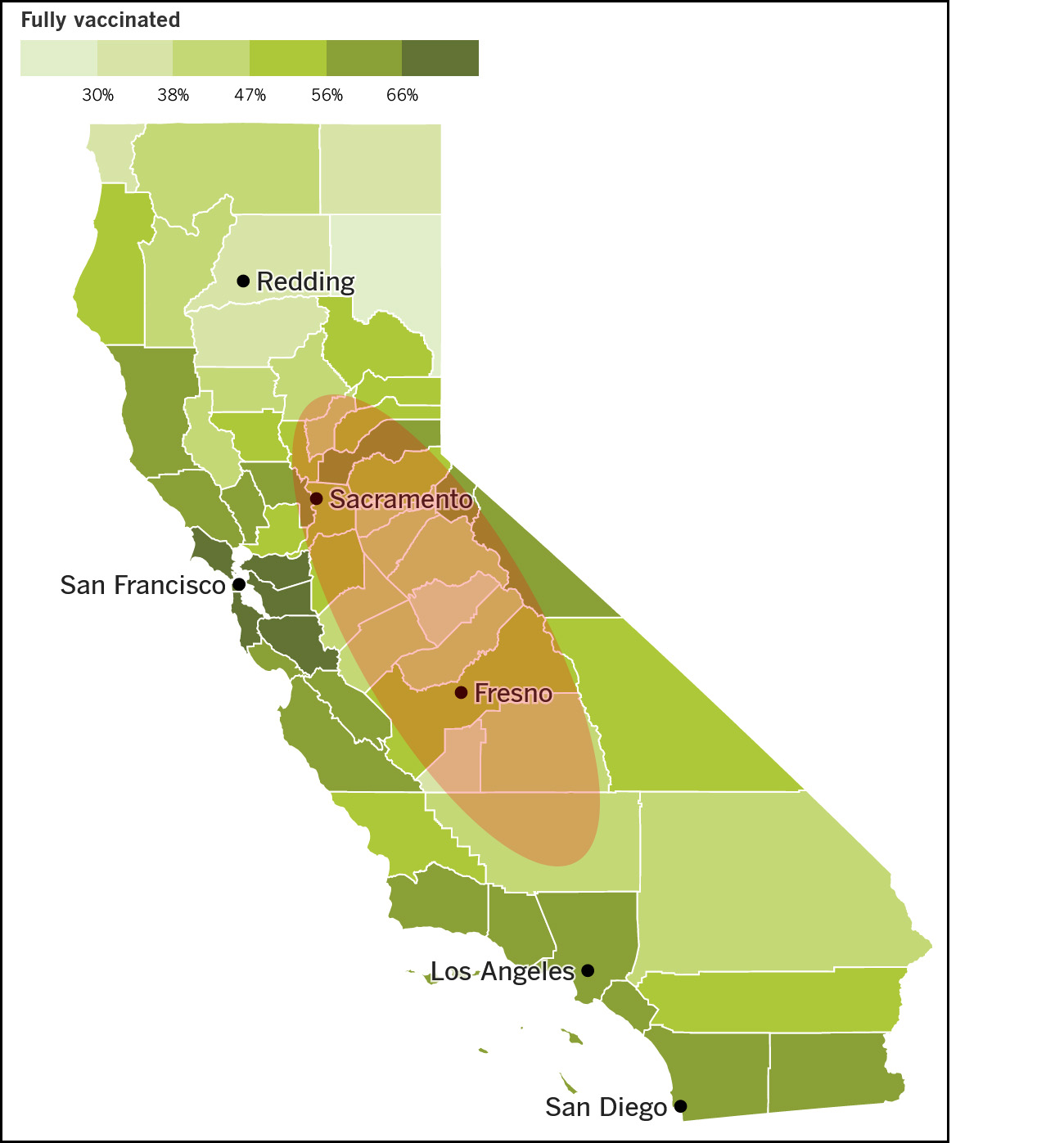
In Silicon Valley, 73% of residents have been vaccinated. In Tulare County it's 41%. To steal James Carville's old saw about Pennsylvania, California is San Francisco on one end, Los Angeles on the other, and Alabama everywhere else.
One of the consistent themes on this blog is that life is improving faster and for more people than we generally acknowledge. Usually I defend this by showing rising trends in big-picture subjects like crime, poverty, income, happiness, and so forth.
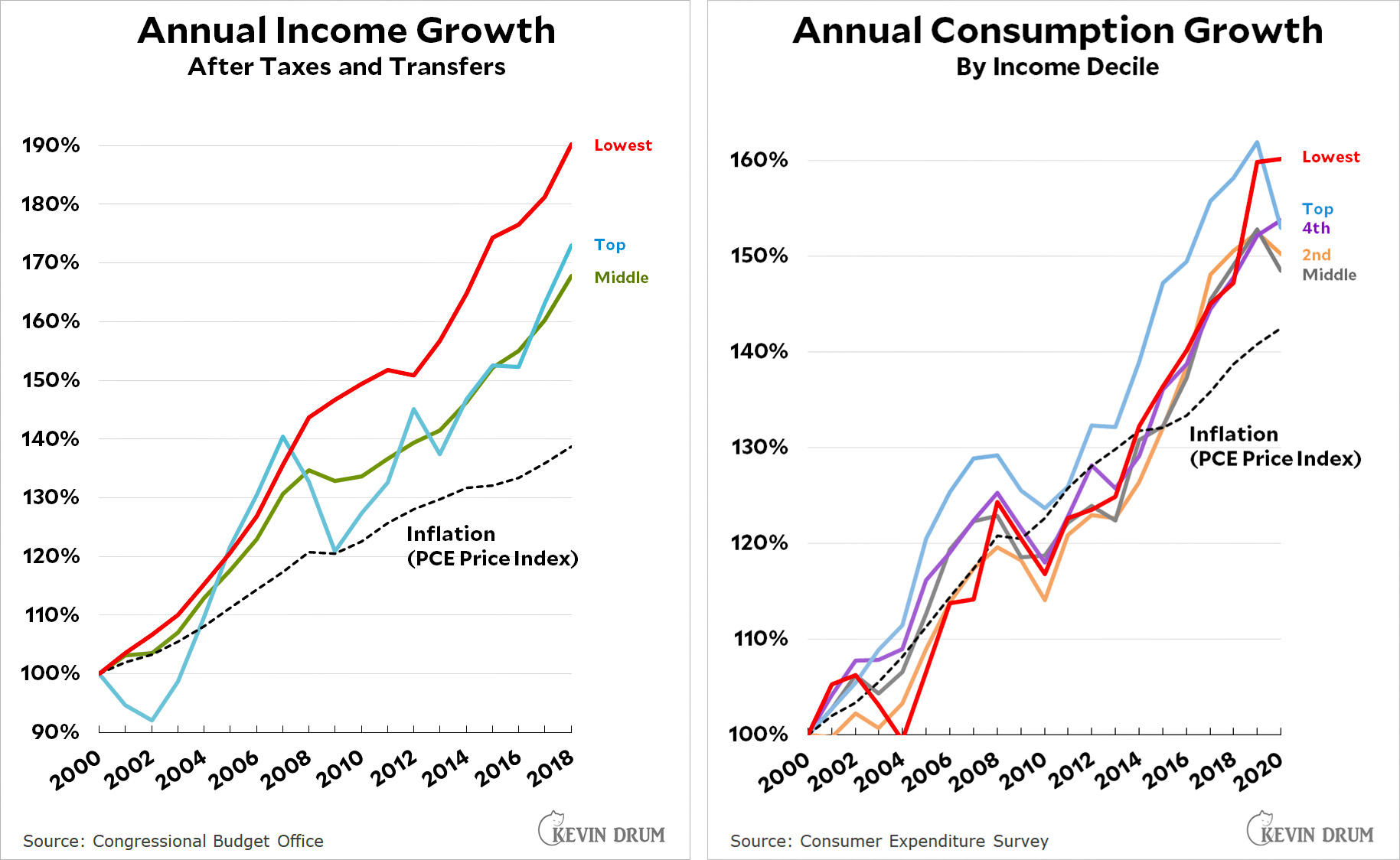
But this is kind of bloodless, so I'm glad to welcome the fine folks at Reason to the "Cheer up!" caucus. No charts here, just "40 Ways Things Are Getting Better."
This is a more eclectic list than mine, ranging from lower crime rates to better pot quality and tolerable non-alcoholic beer. Oddly, they don't include some obvious candidates like smartphones and fast vaccine development, but I suppose you're always bound to miss a few things.
Now, there are some bad trends too. CO2 concentrations in the atmosphere. The Black-white education gap. The conservative descent into Trumpism. What's more, I understand that we're all totally frazzled by 18 months of COVID-19, which makes this an inopportune moment to persuade people that things are better than they think.
But they are! Not every single thing, of course, but almost all of us are generally better off today than we were 20 years ago. Why, according to Reason, even those of you who live in weather-challenged states can get avocados these days. What more do you want?
Here is poor little Hopper in her cone, looking wistfully into the now-forbidden backyard. But there's good news: Her tail seems to be getting better, and tomorrow we have another trip to the vet to find out for sure. And who knows? Maybe things will be in such great shape that we can remove the cone. Thoughts and prayers, people.

During a pandemic, anyone who poses a risk of transmitting the disease is a serious danger to those around them. The usual answer to this is quarantine rules, which historically have been pretty blunt thanks to poor knowledge of how disease transmission works and the lack of any alternatives. But thanks to advances in medical science we're luckier today: in the case of COVID-19 you have a choice of quarantine or getting a quick, safe vaccination.
Importantly, the quarantine option is still available. This is historically the way governments have addressed infectious disease, and there's literally no one who thinks that governments don't have the power to enforce quarantines during an epidemic.
In other words, there's no mandate for anyone to get vaccinated or tested. But if you don't, you're a danger to those around you. What's more, you remain a part of the potential disease pool, which poses a risk of breeding deadlier varieties of COVID-19. For those reasons, the government is fully within its authority to insist that you remain in quarantine until the emergency has passed.
Got it?
According to National Review, President Biden's vaccine mandate is illegal, unconstitutional, morally wrong, and impractical:
Beyond the serious legal and process issues raised by using a rarely invoked OSHA emergency authority to deputize private businesses to prod 80 million Americans into getting vaccinated, there are serious practical questions. And one of the problems with bypassing the typical regulatory process is that those tasked with implementing these requirements will have no opportunity to weigh in on the potential complications.
Just to think of a few complications, under this order, businesses will now have to set up a system for monitoring who has been vaccinated and who has not. They will also have to facilitate weekly testing for those who choose not to be vaccinated, and keep track of the negative tests. Who pays for the tests? What happens in the time that workers are waiting test results? This remains unclear as of now.
Hmmm. This does not seem like much of an organizational hurdle to me. I think the business community will be able to handle this pretty easily.
In any case, I think a lot of people are misjudging the point of the mandate. After all, its biggest flaw has nothing to do with its legal or bureaucratic aspects. It's the fact that the federal government has no practical way of enforcing it.
But that's OK. What Biden is really doing is giving cover to businesses that wanted to do this anyway. Until now, these businesses risked looking partisan if they mandated vaccines, but now they can simply say that it's the law and they have no choice. It lets them off the hook for making the decision.
And what will companies do to employees who refuse to get vaccinated or tested? I assume every company will decide for itself, but again, I think it's beside the point. What's important is that there are lots of people who will do something merely because it's "officially required." We saw the same thing with the Obamacare mandate: the fine didn't really matter. The mere fact that insurance became legally required was enough to make most people comply, even if they grumbled about it. It may not seem like it sometimes, but Americans really are mostly pretty law-abiding folks.
So that's that. The mandate gives cover to businesses and a quasi-legal mandate to individuals. But what's most important is that the message it sends—we're finally serious about this—should be enough to get a lot more people vaccinated regardless of its eventual legal status.
The way things are shaping up, Joe Biden's new vaccine mandate will spark two responses:¹
The question is, which of these will prove to be a more powerful political force? I think Biden is assuming that the anti-vaxxers will never vote for Democrats anyway, so pissing them off costs him nothing. Conversely, he figures that the folks who are vaccinated are really, really tired of the anti-vaxx antics and ready to support a Democratic initiative to just lay down the law. On net, then, Democrats will win support by getting tough on vaccinations.
This will be especially true if Republicans go to the mats in their opposition to vaccinations. They want to be known as the anti-mandate party, but if the nutbag caucus wins the PR fight they're going to become the anti-vaccination party whether they like it or not.
¹Three if you count the always-popular "Whatever."
Well, this is going to be fun. President Biden has finally decided that enough's enough on the vaccine front, so he has instructed the Department of Labor to write a rule requiring all employees of large companies (over 100 employees) to be vaccinated. Also all federal employees. Oddly, though, he didn't take this opportunity to mandate vaccinations for air travel.
Anyway, it will take some time for OSHA to write up the new rule, and it will instantly go to court after it's issued. My tentative take is that . . . I'm not sure about the president's authority to do this. If it were a state government doing it, I don't think there would be any question. But can the federal government do it? At one time I would have been inclined to think that the Interstate Commerce clause provided sufficient authority, but obviously the current Supreme Court will be a hard sell on that. Beyond that you have the vague "promote the general welfare" argument, but that's hardly a slam dunk either.
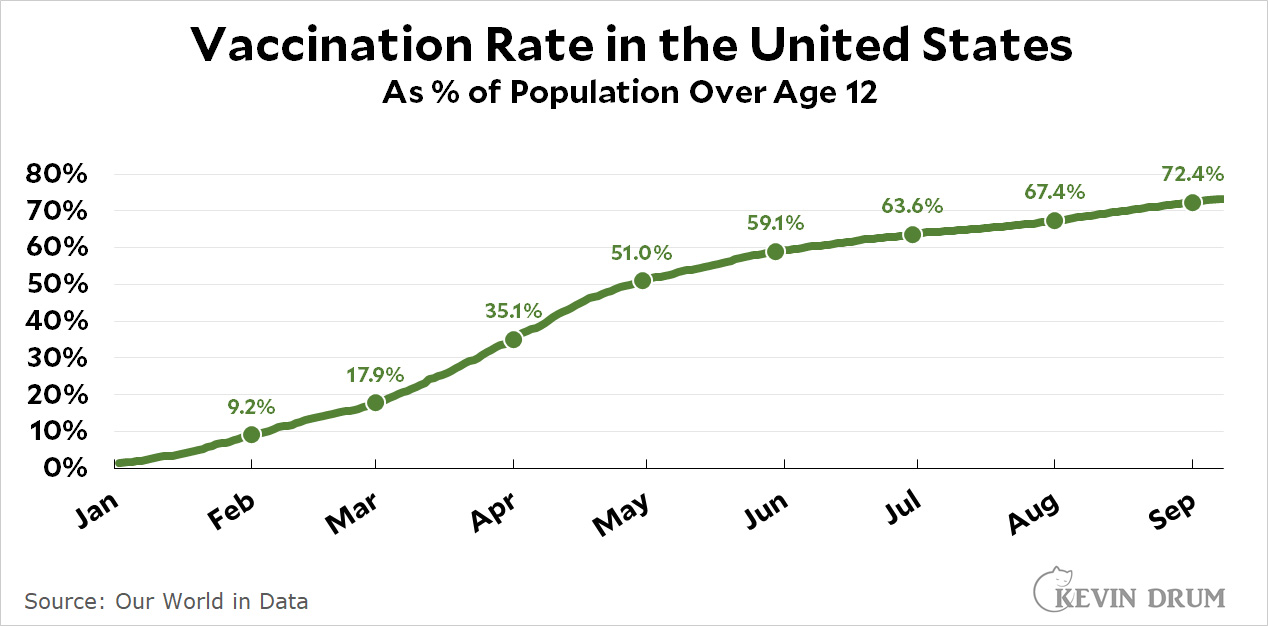 In any case, only about 27% of the adult population has yet to be vaccinated, and I'd guess that close to half of these people work for small companies and won't be affected by the mandate. So even if Biden wins in court, I figure this will get us up to maybe 85% or so. Not bad, but still not enough.
In any case, only about 27% of the adult population has yet to be vaccinated, and I'd guess that close to half of these people work for small companies and won't be affected by the mandate. So even if Biden wins in court, I figure this will get us up to maybe 85% or so. Not bad, but still not enough.
Behold this chart showing the Labor Force Participation Rate over the past few decades:
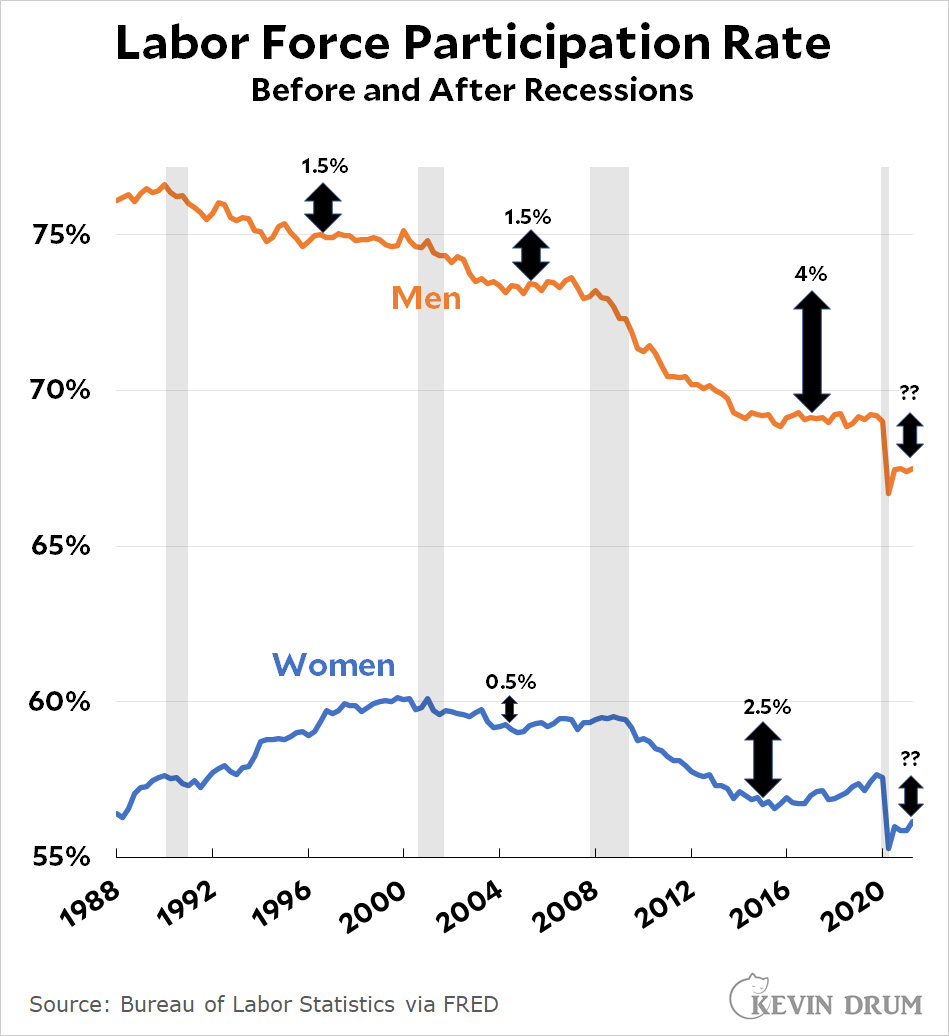
The LFPR is exactly what it sounds like: it's the percentage of the adult population that's either employed or looking for employment. Let's take a look at men first.
After the 1990 recession, the LFPR for men dropped by about 1.5 percentage points and then flattened out. After the 2000 recession, ditto. After the 2008 recession, the loss was about 4 percentage points. In other words, after every recession the LFPR ends up at a permanently lower level.
This has now happened often enough that we should expect something similar to happen this time around: the LFPR will end up dropping about one point or so and then flattening out at around 68%. This is only about 0.5 points above where we are right now, which equates to less than one million people.
Among women we see a similar thing, though it's smaller and didn't start until the 2000 recession. At a rough guess, we should expect the LFPR for women to end up about one point from where it is now, which equates to two million people.
Altogether, then, this makes it look like we'll add about 3 million workers before the LFPR flattens out again. Looking at the unemployment rate provides a similar number. This is a lot less than the 10 million people who are supposedly looking for jobs.
There are no sure things here, but numbers like these are why I continue to think there are fewer people looking for jobs than we think. I'd put it at 3-5 million, at which point the unemployment rate is 3-4% and the economy is operating at 100% of its potential:
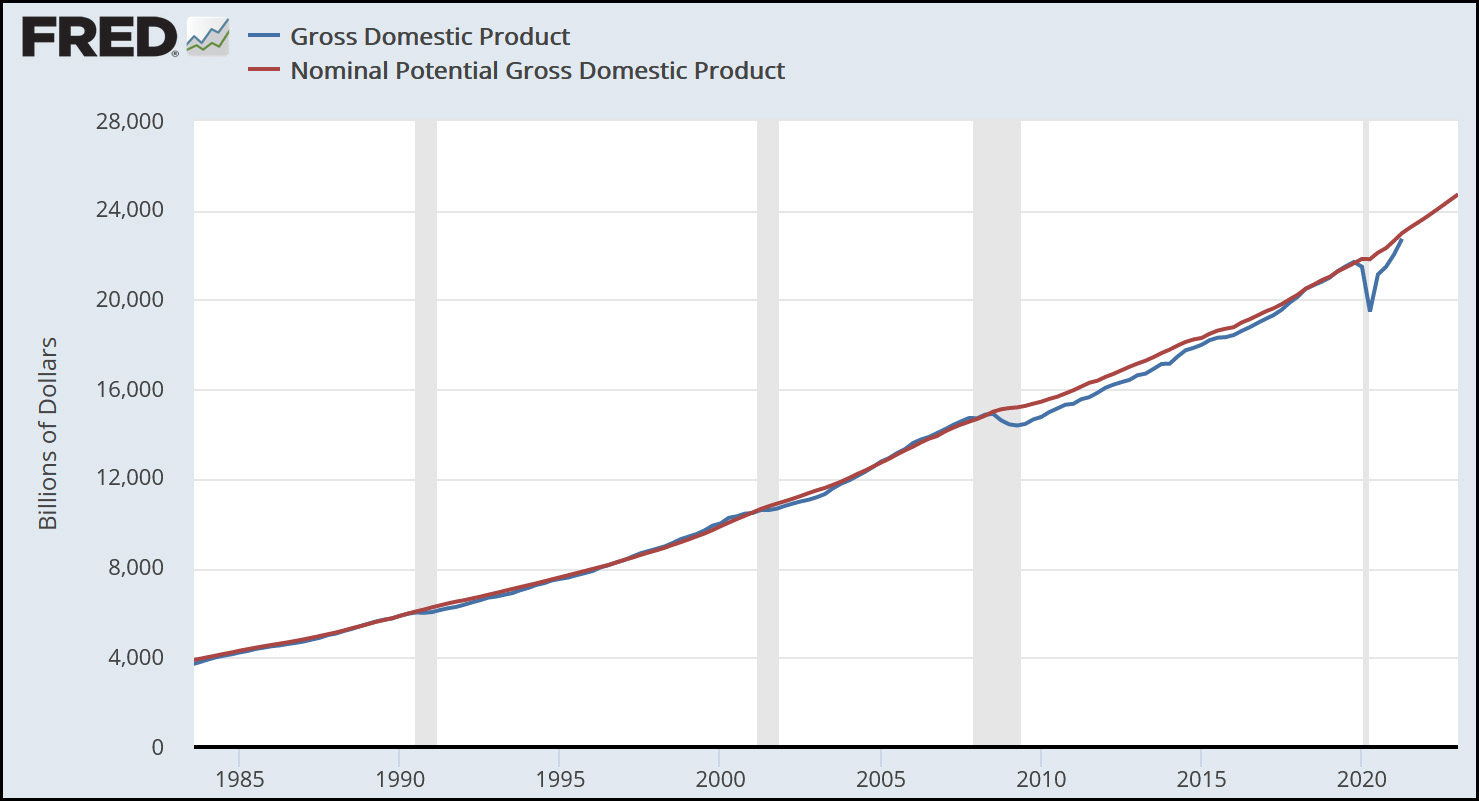
Can we boost the LFPR? Yes indeed. We just have to pay people more to lure them into the job market. Can we raise potential GDP? Also yes, in theory, but that's a slower, more complicated process and no one is entirely sure if we can do it—or what risks it involves. It's currently a matter of some controversy.
I would love to be wrong about this, but I'm not sure I see any reason to think that the US economy is on track to suddenly explode above its potential. The fast and massive stimulus spending did its job, but its job was to speed up our recovery, not to raise the economy to a permanently higher level.¹ The good news is that it did this marvelously. The bad news is that having done it, there's not much more we can expect it to do.
¹Its other job, of course, was to help people who were hard hit by the recession. That's not germane to a macroeconomic discussion, but it's certainly why massive stimulus is worthwhile regardless of its broader effects.